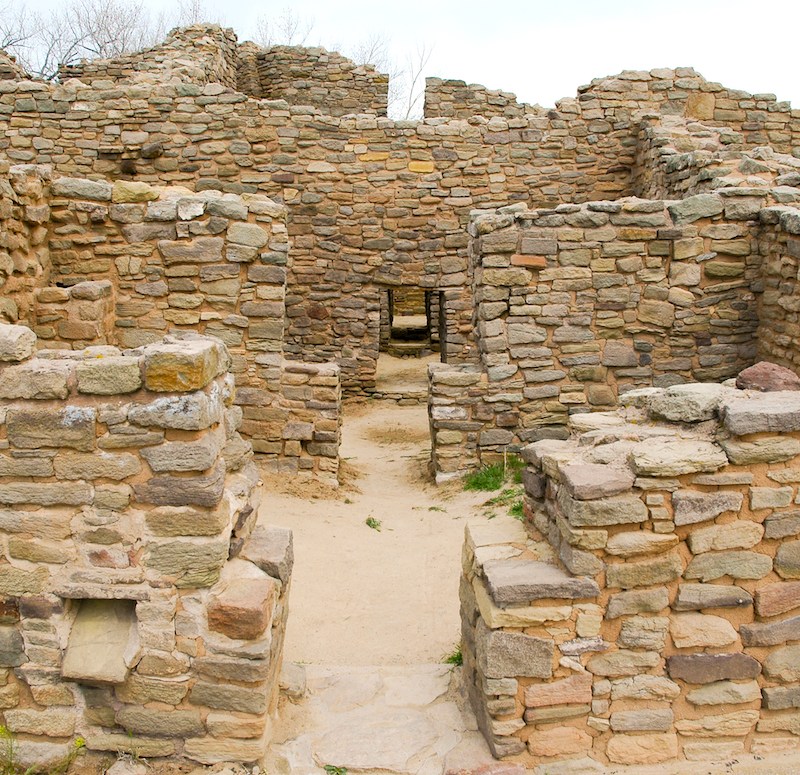
Lying in the beautiful San Juan Basin, on the shores of the Animas River, Aztec, New Mexico, is one of the most scenic small towns in the Four Corners area of the U.S. Southwest. Built in one of the greenest and most fertile areas in the middle of the high desert, the town’s history reaches back thousands of years.
Videos by TravelAwaits
The name “Aztec” was borrowed from the ruins found in the area, though a misnomer. It originated in 1776 when two Franciscan friars stumbled upon them and thought they were the work of the Aztecs. As misguided as the name was (Ancestral Puebloans, not Aztecs, built the ancient city), we still use it for both the ruins and the town to this day.
Though people lived here even before they built the first settlement, the first signs of civilization here date from 1100. After the ancients moved on in 1300, Ute and Navajo tribes camped along the Animas River. Attracted by the fertile land, Anglo and Hispanic farmers established homesteads there with the permission of the U.S. government in the late 1800s.
The town of Aztec was established in the late 1800s, starting from a trading post and a farming community. Visiting Aztec today offers a step back in time to witness its long history, and stands as a gateway to other attractions in the Southwest. The following are a few things to do in and around Aztec.

1. Visit Aztec Ruins National Monument
The ancient ruins the town of Aztec borrowed its name from lay within its boundaries at the end of a neighborhood street. The Ancestral Puebloan ruins preserved within the Aztec Ruins National Monument are also the main reason people visit the town.
Designated a World Heritage Site in 1987 as part of Chaco Culture World Heritage Site, Aztec’s ruins preserve important Pueblo architectural and engineering achievements. Built and inhabited between 1100 and 1300, the Aztec Ruins were first an outskirt of Chaco, but soon became an important public, ceremonial, economic, and political center of its own.
As soon as you enter the park’s premises, you’ll find a visitor center and museum. Stop here first to learn about the ancient city and its history. Then take the self-guided walking tour through the ancient structures and explore the 900-year-old Ancestral Puebloan Great House. You’ll walk along ancient walls and open kivas, and enter a structure with still-covered interconnected rooms.
But the highlight of a visit to Aztec Ruins National Monument is the only reconstructed ceremonial great kiva in the Southwest. Entering this kiva makes it easy to imagine the ceremonial life of the Ancestral Puebloans close to a thousand years ago.
Pro Tip: If you time your visit right, you can participate in special events, like cultural demonstrations and ranger-led talks and tours.
2. Visit The Aztec Museum And Pioneer Village
For a more recent historical perspective, visit the Aztec Museum and Pioneer Village. The main building is housed in the Old City Hall and showcases a collection of some of the best Western American artifacts. It includes information of Aztec’s early settlers, exhibits of minerals and mining tools, early farming and dairy equipment, historic clocks, and early clothing. It also includes a small collection of Native American arts and crafts.
Step outside into the Pioneer Village complex and walk among 12 historically accurate buildings, either originals moved here or replicas built on-premises. You’ll find a tinsmith, print shop, blacksmith, carpentry shop, log cabin, farmhouse, village church, schoolhouse, citizen’s bank house, jailhouse, post office, general store, and doctor’s office.
Various farm equipment highlights the town’s original version as a farming community, while a few railroad track pieces with a caboose focus on the railroad’s importance in establishing Aztec as a town.

3. Take A Walk In Historic Downtown Aztec
Starting at the Aztec Museum, walk down Main Street for a historic tour of the city. Stop at one of the oldest buildings in town, the Jarvis Hotel, built in 1890 and remodeled to include a second story in 1906. Continue your tour with other buildings dating from the early 1900s, including the Aztec Theater, built in 1927.
Soon you’ll reach the Historic Downtown, where you’ll find the most spectacular buildings from the turn of the 20th century. These brick buildings established Aztec as a commercial center.
Influences from the East and the railroad built in town brought businesses, and they all adopted different architectural styles, depending on where they came from. You’ll find New Classical elements, like stained glass windows and pressed metal slidings. Two of the best-preserved examples of these buildings are the Randall Building and the Old Fellows Hall.
Walking among these old buildings, you’ll feel like you’ve traveled back in time, and you’ll understand why Aztec’s Main Street is a designated Historic District. According to the 1984 nomination documents, it is a “particularly well-preserved New Mexican commercial street developed from 1900 to 1915.” They add that “the district appears much as it did in 1915.”
4. Take A Hike In Town And Its Surroundings
Besides history, Aztec is known for its gorgeous scenery and offers great outdoor recreation activities. For an easy stroll along the river, take the paved and accessible Animas River Trail from Hartman Park to Riverside Park. You’ll find a lake, exercise equipment, sports field, and open grass area along the way.
For a longer hike, try the Alien Run Trail at Hart Canyon, a 7.9-mile round-trip trail, just north of town. You’ll find beautiful vistas and gorgeous wildflowers in springtime on this easy trail in the high desert. A multi-use trail, it is popular for mountain bikers. If you are wondering about its name, you’ll find out when you reach a UFO crash site, commemorated by a plaque.

5. Look For Natural Arches In The Region
You might think of Moab and its vicinity when you hear of natural arches, but the landscape surrounding Aztec is also full of them. In fact, the area is home to over 300 documented natural arches in the town’s immediate vicinity. They are not easy to find, but if you reach them, you’ll find yourself alone with the spectacular scenery.
One of the largest and most spectacular is the Cox Canyon Arch, at the end of a short, 0.4-mile trail, just north of town. The trailhead is 15 miles from the center of town, at the end of a short dirt road. To get there, take U.S. 550 North for about ten miles, then turn left onto Road 2300 and Road 2310.
You can access another spectacular arch, simply called Arch Rock, off US 550 North as well, 6 miles out of town, this time taking a right turn on Arch Rock Road, a rough dirt road. You’ll see the arch from the road, but you can also hike around it. As a bonus, you’ll see a few petroglyphs in the area as well.
Pro Tip: To find these and many more arches in the area, ask for a brochure with a map in town. The arches are all off dirt roads, many of them rough, so it is recommended to use a four-wheel-drive vehicle and have a full tank of gas. Make sure you have a paper map, too, in case you lose signal.

6. Use Aztec As A Gateway To Other Four Corner Attractions
The Four Corners region in the vicinity of Aztec offers endless outdoor activities, and the town is the ideal headquarters for many of them.
You’ll find Navajo Lake State Park only 30 miles from Aztec, offering camping, swimming, fishing, boating activities, hiking trails, and two visitor centers with interpretive exhibits. Besides the lake, the park includes Pine River, Sims Mesa, and the San Juan River area.
Visit Salmon Ruins, another Chacoan outlier, about 30 miles from Aztec. Here you’ll find similar structures to Aztec Ruins, including a great kiva (this one isn’t reconstructed though), giving you a closer look into the lives of the Ancestral Puebloans and their ancient cities.

In a different direction, also about 30 miles from town, the Angel Peak Scenic Area offers gorgeous views of the high desert badlands, including the 7,000-foot Angel Peak and a canyon at its base. Petrified wood and mammal fossils add to the appeal of the landscape. You’ll find several campsites and picnic areas overlooking the canyon here.
You can also visit Chaco Culture National Historical Park, about 70 miles from Aztec. Much larger and more elaborate than both Aztec and Salmon Ruins, Chaco was once the center of the world of the Ancient Puebloans. As you look at the structures here, you’ll see the connection between the three sites.
7. Eat And Stay Overnight
With so many things to do, you’d want to spend at least one night in Aztec. Though you don’t have many choices, the Microtel Inn and Suites offers a comfortable stay and breakfast, and an outdoor area with a fireplace, where you can sit and enjoy the surrounding beauty of the high desert.
Dine at Rubia’s on Main Street in an old building for Mexican fare, though you’ll find Southwestern and vegetarian choices here, too. Or choose Aztec Restaurant for your old-fashioned all-American fare.
Pro Tip: A small town in the middle of the high deserts of the Four Corners area, Aztec combines gorgeous scenery, history, and archaeology, making it one of the best places to use as a portal to learning about this unique area of the world.
